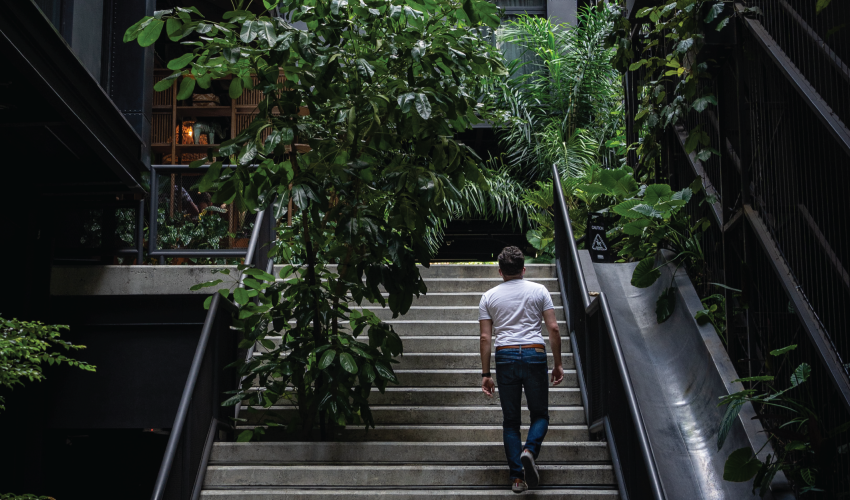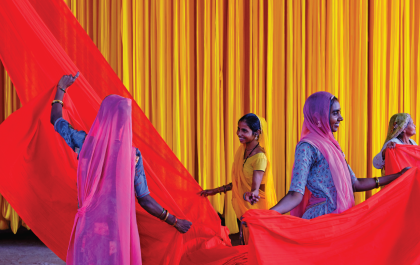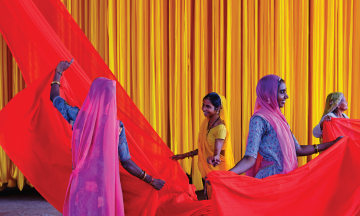By Abak Hussain
Somewhere deep in our DNA, we all know it to be true: spending time immersed in nature is good for us. It would make sense then, to hold on to our trees for dear life, and invest more in greening up our urban spaces – this means parks, vertical gardens, or even larger forest areas enclosed within city boundaries. But so often we act counter to our interests, cutting down existing trees while paying lip service to planting them, filling up water bodies, and making room for ugly development projects. Every square inch of space, after all, has monetary value so who cares if the effects are catastrophic for the environment? The word Banani used to mean forest, and Gulshan meant garden. What a cruel joke that has all become.
Our unmatched ability to push our own habitat past the brink of peril is perhaps one of the most enduring of mysteries – and the health crisis we are seeing, both physical and mental, with young people being diagnosed with illnesses that were not supposed to show up until old age or late middle age, is a predictable outcome. We are still processing the actions of a regime that cared about nothing more than lining its own pockets, and even now are clamoring to come back. Just last year, hundreds of trees were cut down in Satmasjid Road in Dhaka, and while the destruction was eventually brought to a stop – thanks to the work of tireless environmental activists – way too much damage was already done. We will never get those trees back.
Actions like these, combined with the illegal filling up of thousands of acres of water bodies, paving way for the construction of unsustainable high-rises has, over the years, turned Dhaka into one of the most polluted and unlivable cities in the world. But still, we hold on to hope, because what else is there? Many in the government are now trying desperately to turn a new leaf, but the fight is daunting – people don’t want to listen when there is quick cash to be made. The recent initiative to ban plastic bags was a good one, let’s hope it doesn’t fizzle out in time. The need of the hour is really to hold polluters accountable, and put into place stringent codes that stop the unchecked construction that is taking place all over our capital city. In short, urban residents need clean, green areas they can escape to without having to leave the city. Just imagine strolling over to a place where the air is fresh, and the peace and quiet can revitalize us, body and soul. If there is an existing green field with blades of natural grass growing out of God’s earth in a park area, maybe we should leave it alone instead of digging it all up to build some asinine astro turf which nobody asked for.
If this sounds overly idealistic, that’s only because we have normalized such nasty money-grubbing practices in the first place. But other countries, some poorer than us, have recognized the need for trees, and they have acted. Nairobi, a city in many ways less developed than our capital, has invested heavily in Karura Forest, which sits fully within the city limits of Kenya’s densely populated capital. Kenyans are now reaping the benefits, and the serene area which supports plenty of biodiversity is also a tourist favorite. With over 1,000 hectares of forest land, Karura is the perfect place for walking, jogging, bird watching, or simple forest-bathing. I myself had the privilege of visiting the area a few years ago, and I remember feeling, as I walked down the trail into the heart of the forest, the cortisol levels go down with each step.
Forest-bathing: That most Japanese of Japanese concepts – it would do all urban residents a world of good to take a bit of time out of each week, go somewhere full of trees, and mindfully disconnect from all the city noise. But where? Dhaka has made a few whimpering attempts in the form of parks, and while they are better than nothing, they do not provide anywhere near the tranquility we would need for a proper day of shinrin-yoku. The air inside the nicer parks in Dhaka North might be a tad cleaner than out in the road during heavy traffic, but still, it is not great quality, and having to wear a mask while walking in the park takes the fun out of it. And even these parks are beyond the reach of most of the population. Furthermore, traffic and construction noises continue to mar the experience, and construction projects create an ungodly amount of dust from which there is no escape. All that is to say, even our parks are a highly compromised experience. It is important to protect not just the inside of our parks, then, but the surrounding areas. And we really, really, really need to wean ourselves o ff the need to build gaudy skyscrapers on any empty patch of land we manage to grab. When I say this city has made it hard to breathe, it is not a bit of trite poetry. Quite literally we are struggling to breathe, just look at the AQI, and construction is the second-biggest culprit behind this pollution – right after brick kilns.
Nairobi’s Karura Forest was largely possible because visionary activist Wangari Maathai fought relentlessly to protect it. No doubt, there were many greedy parties eyeing that land for years, but in order to protect nature and elevate the quality of life in the long run, Kenya recognized the need to move beyond thinking about the next quick buck and look towards long-term wealth, which includes our health. The value of a forest area is incalculable, and they don’t teach you that in business school. Kenya, in spite of its many socioeconomic problems, gets it. Singapore gets it, which is why it has invested heavily in turning itself into a garden city, and has even filled its airport with trees to the extent that people often intentionally extend their layovers in Changi airport – what a miraculous feat to make an airport feel peaceful! The Nordic countries get it. North America is full of vibrant urban centers with pockets of nature containing pristine streams and hiking trails. Vancouver and Seattle are examples of cities where people can work in cutting edge industries but also retreat into nature and come back to work before lunch time is over. Houston offers 36 acres of parkland for every 1,000 people. Then there are the other South American and African countries other than Kenya which prioritize on protecting their full-scale urban forests. Two notable examples are Rio de Janeiro, Brazil, and the Johannesburg, South Africa. Seoul, South Korea, a city known for its dense urban agglomeration, takes care to maintain Seoul Forest – 1,200 hectares of forest land easily accessible by subway. Medellin, Colombia, has created what it calls green corridors in the city by planting hundreds of thousands of trees – this project has successfully reduced air pollution and cooled the city.
Just like Wangari Maathai did long ago, many are now realizing the obvious truth that we are part of nature, and if we get rid of all the trees, we are doomed. This great Kenyan activist was a Nobel-peace prize winner, as is Bangladesh’s current head of government, Chief Adviser Dr Muhammad Yunus. So perhaps there is a glimmer of hope, and some similarity in thought. The CA is indeed an enlightened individual, with environmental protection on his mind, but unfortunately, the challenges at hand for him right now are just a bit too much for any human, and any progress could come undone if governmental institutions are not fixed first. Mental health professionals often say there are three main cures of the malaise of urban life: social connection, physical activity, and going out in nature. The infrastructural problems of Dhaka make all of them difficult: how do you socialize when going to someone’s house means fighting through such nauseating traffic? How do you get physical activity when there are no walkable areas, and the polluted air offsets any benefits? And as for going out in nature … well, what nature? We messed it all up. I could optimistically suggest that we simply need to start planting trees, fill up the city with park space, reclaim stolen land, tear down ugly high-rises, and decentralize facilities in order to thin out the population, but is that just pie in the sky? Can we really create a city where an invigorating walk through the trees to wash o ff the grime of a stressful day is not too much to ask for? I choose to remain hopeful, and contribute in whatever way I can. Maybe we will get there. After all, isn’t green one of our flag colors?
Abak Hussain is Contributing Editor at MW Bangladesh.













